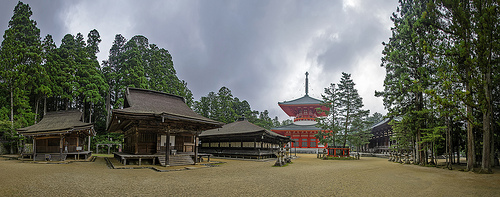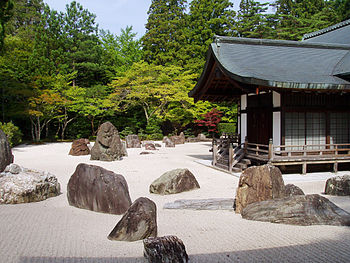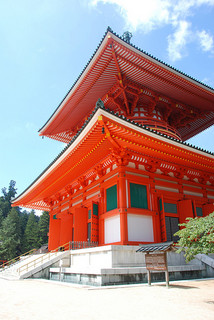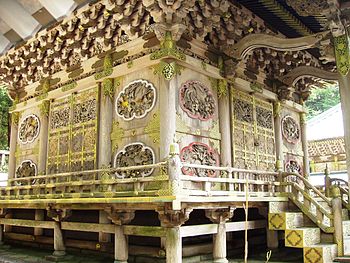There are several buildings on the grounds of Kongobu-ji 金剛峯寺, the head temple of the Koyasan Shingon sect of Buddhism. The area is known as Danjo Garan, and is part of the Koyasan UNESCO World Heritage site. The temple itself was originally built in 1131 in honor of Toyotomi Hideoshi’s deceased mother, and was originally called Seigan-ji.

Panorama of Danjo Garan (壇場伽藍) on Koyasan (Photo credit: acase1968)
The current building was erected in 1863 after the previous one was destroyed. Inside are many sliding screen doors painted by the famous artist Kano Tanyu (1602-1674) and others trained in his style. Kongobu-ji also has the largest rock garden in Japan.

Kongobuji Temple, Koyasan, Wakayama prefecture, Japan. Banryutei rock garden. (Photo credit: Wikipedia)
Called Banryutei 蟠龍庭, the garden was completed in 1984 and extends over 2340 square meters (over 25,000 square feet). The garden has white sand from Kyoto and 140 granite rocks from Shikoku. They are arranged into a design of two dragons rising from clouds to protect the temple. Admission is 500 yen for Kongobu-ji and the garden.

Konpon Daito Pagoda (Photo credit: Maarten1979)
Another structure of note in Danjo Garan is the Konpon Daito pagoda, center of a 3-dimensional mandala. Look for the Fudo-do, a beautiful, small hall dedicated to the gods Fudo and Hachidai-doji. It was designed by the 3rd empress of Emperor Toba, Hachijoin, who lived from 1137 to 1211. The hall has a feminine air reflecting the architecture of a Heian Period residence.The Dai-to and Kon-do are two other buildings which visitors can enter for a fee of 200 yen each.

Tokugawa Mausoleums, Koyasan, Wakayama prefecture, Japan. Detail view. (Photo credit: Wikipedia)
The Tokugawa Mausoleum also costs 200 yen to enter. It was competed in 1643 for the 3rd Tokugawa Shogun, Iemitsu. The exterior is unfinished wood but the interior is beautifully decorated in gold and silver leaf. The Reiho-kan is the treasure hall, which costs 600 yen for the regular admission. It contains many national treasures and Buddhist artworks. A combination ticket gives admission to all of these places in Danjo Garan for 2,000 yen. They can be reached by taking the bus from the Koyasan cable car to the Kongobu-ji-mae stop. It is about a 5 minute walk from the bus stop.
